“Diagnosis” from One Secret Thing by Sharon Olds, copyright © 2008 by Sharon Olds. Used by permission of Alfred A. Knopf, and imprint of the Knopf Doubleday Publishing Group, a division of Penguin Random House LLC.
ORIGINAL TEXT AND AUDIO - 2017
On this day in 1679, Daniel Greysolon, Sieur du Lhut, first reached Lake Superior, about where the city that bears his name — Duluth — now lies. He was a French soldier and explorer, and had visited Montreal on several occasions. In 1675, he bought a house there, and started thinking about making a trip to the headwaters of the Mississippi River. He became friends with the Sioux Indians, and in 1678 he set out with seven French followers and three Indian slaves, intending to broker a peace agreement between the Sioux and the Ojibwe Indians north and west of Lake Superior, and firm up the tribes' fur trading relationship with New France. He negotiated the peace treaty, arranged some inter-tribal marriages, and encouraged the tribes to hunt together, before moving west to explore the Mississippi and St. Croix rivers.
On this day in 1698, British engineer Thomas Savery patented the first steam engine. He wanted to find a way to pump water out of coal mines, and eventually he built a machine that was filled with water itself. When steam was introduced under pressure, the water level rose and created a vacuum that drew more water up through a valve below. He described it in his book The Miner's Friend (1702) as "a new invention for raising of water and occasioning motion to all sorts of mill work by the impellent force of fire, which will be of great use and advantage for draining mines, serving towns with water, and for the working of all sorts of mills where they have not the benefit of water nor constant winds."
Though Savery's invention worked, his machine was never used in mines due to fears that the boilers would explode. It also wasn't cost-efficient and used large amounts of fuel to run the boiler, and the soldered joints wouldn't tolerate much pressure. Savery coined the term "horsepower" in describing how powerful his steam engine was; because mines had previously been drained using horses and buckets, he claimed his machine had the power of 10 horses.
It was on this day in 1937, that Amelia Earhart was last heard from, somewhere over the Pacific. She and her navigator, Fred Noonan, had set off in May from Miami to fly around the world in a Lockheed Electra. She said, "I have a feeling that there is just about one more good flight left in my system, and I hope this trip is it."
They had completed all but about 7,000 miles of the trip when they landed in New Guinea. Maps of this part of the Pacific were inaccurate, and U.S. Coast Guard ships were in place to help guide them to their next stop, the tiny Howland Island. The weather was cloudy and rainy when they left New Guinea. At 7:42 a.m., Earhart communicated to the Coast Guard Cutter Itasca: "We must be on you, but we cannot see you. Fuel is running low. Been unable to reach you by radio. We are flying at 1,000 feet." Her last transmission, about an hour later, was "We are running north and south."
Today is the birthday of Hermann Hesse, born in Calw, Germany, in 1877. In 1911, he took a trip to India and started studying Eastern religions, and ancient Hindu and Chinese cultures. His travels inspired his novel Siddhartha, about the early life of Gautama Buddha. It became popular among the counterculture movement of the 1960s, more than 40 years after it was published.
He said: "The world is not imperfect or slowly evolving along a path to perfection. No, it is perfect at every moment, every sin already carries grace in it."





Yes, the ending made me chuckle.
The description of the Savery Engine is unfortunately incorrect. He did not use high pressure steam. Steam was injected into an empty vessel. Valves closed, then the steam was condensed with water poured over the exterior causing a vacuum. Valve to mine water would then be opened and atmospheric pressure from outside would push water up pipe into low pressure chamber. Input valve then closed and water removed. Process would then repeated.